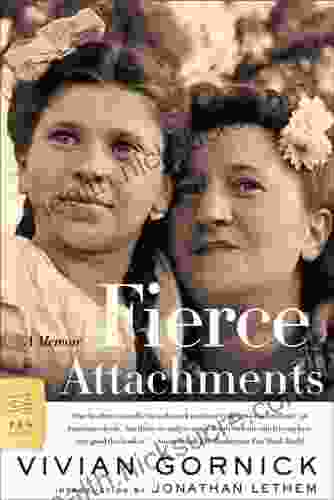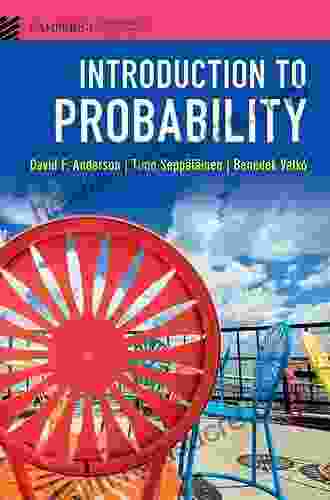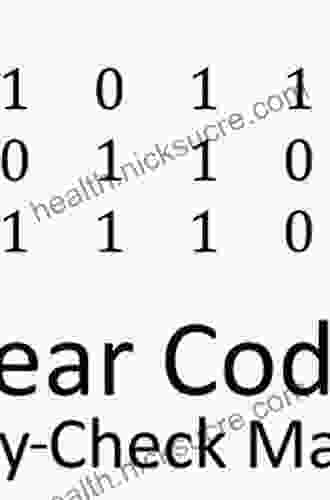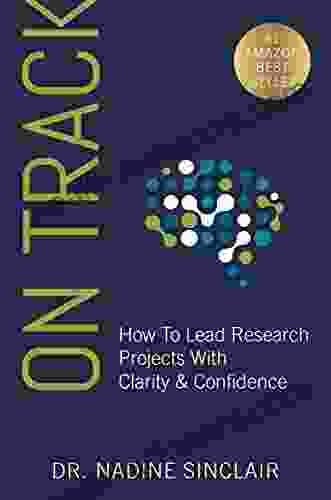Unveiling the Power of Error Correcting Linear Codes: A Comprehensive Guide

In the digital realm, where information is transmitted and processed, errors are an inevitable occurrence. These errors can arise from various sources, such as noise, interference, or transmission errors, and may lead to data corruption or loss. To combat this challenge, error correcting codes (ECCs) have emerged as a powerful tool to ensure reliable data transmission.
4 out of 5
| Language | : | English |
| File size | : | 16092 KB |
| Print length | : | 827 pages |
| Screen Reader | : | Supported |
Error correcting linear codes, a specific class of ECCs, play a crucial role in modern communication systems, data storage devices, and other applications where data integrity is paramount. This comprehensive guide delves into the concepts, types, and applications of error correcting linear codes, empowering you with the knowledge to harness their power and safeguard your data.
Understanding Error Correcting Linear Codes
Error correcting linear codes are mathematical structures designed to detect and correct errors that occur during data transmission. They are based on the concept of redundancy, where additional information is added to the original data to facilitate error detection and correction.
Formally, an error correcting linear code is defined as a subspace of a vector space over a finite field. The codewords, elements of the code, are generated by linear combinations of the basis vectors of the subspace. This linear structure allows for efficient encoding and decoding processes.
Types of Linear Codes
There are various types of error correcting linear codes, each tailored to specific applications and error scenarios. Prominent among them are:
- Hamming codes: Simple and effective codes designed for single-bit error correction.
- BCH (Bose-Chaudhuri-Hocquenghem) codes: More complex codes capable of handling multiple-bit errors with high efficiency.
- Reed-Solomon codes: Widely used in various applications, including optical storage and data transmission systems, offering strong error correction capabilities.
Encoding and Decoding Processes
Encoding is the process of adding redundancy to the original data using a generator matrix, which defines the linear combinations that create codewords.
Decoding, on the other hand, involves analyzing the received codeword to detect and correct errors. Decoding algorithms leverage the error-correcting capabilities of the code to determine the original data despite the presence of errors.
Applications of Error Correcting Linear Codes
Error correcting linear codes find wide application in industries and technologies that rely on reliable data transmission and storage:
- Communication systems: Ensuring error-free data transmission over noisy channels and unreliable networks.
- Data storage devices: Protecting stored data from errors caused by media defects or environmental factors.
- Medical imaging: Enhancing the accuracy of medical images by correcting errors that may arise during acquisition or transmission.
- Aerospace and defense systems: Ensuring reliable communication and data integrity in mission-critical applications.
Benefits of Using Error Correcting Linear Codes
Incorporating error correcting linear codes into data transmission and storage systems offers numerous benefits:
- Reliable data transmission: Protecting data from errors during transmission and ensuring its integrity at the receiver's end.
- Enhanced data storage: Safeguarding stored data from corruption and ensuring its accuracy over time.
- Increased efficiency: Reducing the need for retransmissions or data recovery mechanisms, optimizing bandwidth utilization and reducing latency.
Error correcting linear codes are a cornerstone of modern communication and data storage systems, providing a robust means to detect and correct errors, thus ensuring reliable data transmission. By understanding their principles, types, and applications, you can harness their power to protect your data and ensure its integrity, ultimately enhancing the performance and reliability of your systems.
Embrace the world of error correcting linear codes and safeguard your data against the inevitable challenges of the digital realm.
4 out of 5
| Language | : | English |
| File size | : | 16092 KB |
| Print length | : | 827 pages |
| Screen Reader | : | Supported |
Do you want to contribute by writing guest posts on this blog?
Please contact us and send us a resume of previous articles that you have written.
 Fiction
Fiction Non Fiction
Non Fiction Romance
Romance Mystery
Mystery Thriller
Thriller SciFi
SciFi Fantasy
Fantasy Horror
Horror Biography
Biography Selfhelp
Selfhelp Business
Business History
History Classics
Classics Poetry
Poetry Childrens
Childrens Young Adult
Young Adult Educational
Educational Cooking
Cooking Travel
Travel Lifestyle
Lifestyle Spirituality
Spirituality Health
Health Fitness
Fitness Technology
Technology Science
Science Arts
Arts Crafts
Crafts DIY
DIY Gardening
Gardening Petcare
Petcare Matthieu Auzanneau
Matthieu Auzanneau Raychelle Cassada Lohmann
Raychelle Cassada Lohmann Aly Raisman
Aly Raisman James Ferguson
James Ferguson Mary Elizabeth O Brien
Mary Elizabeth O Brien Greg Henry
Greg Henry Tim Rappleye
Tim Rappleye Eddie Guerrero
Eddie Guerrero N B Hankes
N B Hankes Eugen Herrigel
Eugen Herrigel John Kavanagh
John Kavanagh Robin Riley
Robin Riley Anna Costaras
Anna Costaras Vincent Schilling
Vincent Schilling Edmund Richardson
Edmund Richardson Lexie Scott
Lexie Scott Michael Shermer
Michael Shermer Deborah Ann Davis
Deborah Ann Davis Julie Schwietert
Julie Schwietert Daniel J Siegel
Daniel J Siegel Kenneth Igiri
Kenneth Igiri Alistair Higham
Alistair Higham Etienne Noumen
Etienne Noumen Charles J Robinson
Charles J Robinson The Editors Of Outside Magazine
The Editors Of Outside Magazine Greg Strandberg
Greg Strandberg Allan Phillips
Allan Phillips Y R Davis
Y R Davis Maria Thompson Daviess
Maria Thompson Daviess Julie Morgenstern
Julie Morgenstern Alan Watts
Alan Watts Allison Williams
Allison Williams Christian Asonye
Christian Asonye John Michael Kelly
John Michael Kelly Jeff Hawkins
Jeff Hawkins Jim Rahtz
Jim Rahtz Kelsey Banfield
Kelsey Banfield Allan Kardec
Allan Kardec Despina Meris
Despina Meris Allen R Angel
Allen R Angel Beth Cavenaugh
Beth Cavenaugh Signe Pike
Signe Pike John Bul Dau
John Bul Dau Ed Robinson
Ed Robinson Brian Treanor
Brian Treanor Brian Lopes
Brian Lopes Simone Milasas
Simone Milasas Dave Pelz
Dave Pelz Robert Taylor
Robert Taylor Kevin West
Kevin West Edmund G R Kraal
Edmund G R Kraal Michael Reist
Michael Reist Jay Blahnik
Jay Blahnik Pottermore Publishing
Pottermore Publishing Allison Alexy
Allison Alexy Robert Penn Warren
Robert Penn Warren Elliot Aronson
Elliot Aronson Debi Pearl
Debi Pearl S Allen Counter
S Allen Counter Sid Roth
Sid Roth Julie Currin
Julie Currin John Hughes
John Hughes Wendelin Van Draanen
Wendelin Van Draanen Jenara Nerenberg
Jenara Nerenberg Gary Leland
Gary Leland Sean Patrick
Sean Patrick Tress Bowen
Tress Bowen Maria Rickert Hong
Maria Rickert Hong Scott Graham
Scott Graham Meredith Russo
Meredith Russo Courtney Summers
Courtney Summers Michele Stanten
Michele Stanten Valerie Gilpeer
Valerie Gilpeer Allen G Taylor
Allen G Taylor Robbin Gregory
Robbin Gregory Jared Cohen
Jared Cohen Giuseppe Mascoli
Giuseppe Mascoli Elce Junior Lauriston
Elce Junior Lauriston Gregory Cochran
Gregory Cochran Suzanne O Sullivan
Suzanne O Sullivan Josephine Perry
Josephine Perry Emma Shelford
Emma Shelford Mark Kistler
Mark Kistler Susan Kuklin
Susan Kuklin Lewis Carroll
Lewis Carroll Grace E Stewart
Grace E Stewart C S Wilde
C S Wilde Ashley D Kendall
Ashley D Kendall Carl Paoli
Carl Paoli Godfrey Higgins
Godfrey Higgins Lynn Stafford Yilmaz
Lynn Stafford Yilmaz Clive Cussler
Clive Cussler Kenji Tokitsu
Kenji Tokitsu Allen Stroud
Allen Stroud Nick Riley
Nick Riley Ronald E Mickens
Ronald E Mickens Karen Murphy
Karen Murphy Dr Ron M Horner
Dr Ron M Horner James Patterson
James Patterson Kate Wood
Kate Wood Allen N Mendler
Allen N Mendler Stephen Haddelsey
Stephen Haddelsey Todd Wilbur
Todd Wilbur J R R Tolkien
J R R Tolkien Joseph Fort Newton
Joseph Fort Newton Nikki Solano
Nikki Solano Paul J Kosmin
Paul J Kosmin Jeff Burlingame
Jeff Burlingame Chris Cannon
Chris Cannon Paul Green
Paul Green Tom Babin
Tom Babin Rebecca St James
Rebecca St James William A Haviland
William A Haviland Roy Shepard
Roy Shepard Jon S Bailey
Jon S Bailey Priya Ardis
Priya Ardis Mary Quinlan Mcgrath
Mary Quinlan Mcgrath Bruce Tremper
Bruce Tremper Roy Macskimming
Roy Macskimming Joe Kelly
Joe Kelly Jim Cheney
Jim Cheney Chris Chambers
Chris Chambers Robert Green
Robert Green Matthew Syed
Matthew Syed Konnie Wong
Konnie Wong Tami Overhauser
Tami Overhauser George M Johnson
George M Johnson Natasha Devon
Natasha Devon Jennifer Waldburger
Jennifer Waldburger Allan G Bluman
Allan G Bluman Brian Boone
Brian Boone Casi Mclean
Casi Mclean Marianne Williamson
Marianne Williamson Nevin Martell
Nevin Martell Charles Conn
Charles Conn Olajumoke Adenowo
Olajumoke Adenowo Carla Simpson
Carla Simpson James Fallows
James Fallows Rene Almeling
Rene Almeling Michaelbrent Collings
Michaelbrent Collings Pasco Valana
Pasco Valana Eickhel Mendoza
Eickhel Mendoza Leonard Shlain
Leonard Shlain Susan Ware
Susan Ware Bill Varney Jr
Bill Varney Jr Karen Wambach
Karen Wambach Steve J Martin
Steve J Martin Stephen R Covey
Stephen R Covey Tim Roughgarden
Tim Roughgarden Jeff Brent
Jeff Brent Eric Lemarque
Eric Lemarque Pure Calisthenics
Pure Calisthenics Kim Heacox
Kim Heacox Kaitlyn Hill
Kaitlyn Hill Allen Carr
Allen Carr Grace Lindsay
Grace Lindsay Norrinda Brown Hayat
Norrinda Brown Hayat Laerke Recht
Laerke Recht Allen O Bannon
Allen O Bannon William W Dressler
William W Dressler Itzik Ben Gan
Itzik Ben Gan Jim Downs
Jim Downs Greg Moran
Greg Moran Pass Your Class
Pass Your Class Matthew Mccoy
Matthew Mccoy Anna Leinberger
Anna Leinberger Eric Naguski
Eric Naguski Shawn D Madden
Shawn D Madden Petr Zima
Petr Zima Alison Aulakh
Alison Aulakh Richard H Thaler
Richard H Thaler Ronald Hutton
Ronald Hutton Jacqueline H Wolf
Jacqueline H Wolf Jack Smith
Jack Smith Alexandra Amor
Alexandra Amor Robert M Sapolsky
Robert M Sapolsky Rob Shelsky
Rob Shelsky Muthukumaran Mani
Muthukumaran Mani Karen Blumenthal
Karen Blumenthal Cy Tymony
Cy Tymony Toru Toba
Toru Toba Jonathan E Steinhart
Jonathan E Steinhart Mark Beauregard
Mark Beauregard Aubrey Gordon
Aubrey Gordon Bobby Clampett
Bobby Clampett Jason Durham
Jason Durham L H Nicole
L H Nicole Jdmission Senior Consultants
Jdmission Senior Consultants Alicia Jasinska
Alicia Jasinska C Calvin Jones
C Calvin Jones Joshua Elliot James
Joshua Elliot James Rick Johnson
Rick Johnson Jim C Hines
Jim C Hines Stuart Holmes Coleman
Stuart Holmes Coleman Sharon Weinberger
Sharon Weinberger Christina Hoff Sommers
Christina Hoff Sommers Emily Thiede
Emily Thiede Kota Nozomi
Kota Nozomi Liz Evers
Liz Evers Karen Bonnell
Karen Bonnell Allen Dulles
Allen Dulles Roy Clark
Roy Clark Molly Forbes
Molly Forbes Novak Djokovic
Novak Djokovic Joosr
Joosr Judith Mckay
Judith Mckay Glenn Tinnin
Glenn Tinnin Harald B Teicher
Harald B Teicher Segun Adebajo
Segun Adebajo Amy Wenzel
Amy Wenzel Annabeth Headrick
Annabeth Headrick Myrna Blyth
Myrna Blyth Alison Gervais
Alison Gervais Maria Hannay
Maria Hannay Allison Norfolk
Allison Norfolk Ken Cohen
Ken Cohen Carrot Quinn
Carrot Quinn Mandi Hickman
Mandi Hickman Linda S Jones
Linda S Jones Peter Van Der Linden
Peter Van Der Linden Kwame Onwuachi
Kwame Onwuachi Meritxell Castells
Meritxell Castells Alison Pearlman
Alison Pearlman Mary Bergin
Mary Bergin Lennard Bickel
Lennard Bickel Selene Yeager
Selene Yeager David Eagleman
David Eagleman Kathleen Bachynski
Kathleen Bachynski Maurice Isserman
Maurice Isserman Sportsman S Connection
Sportsman S Connection Phil Hornshaw
Phil Hornshaw Lynn Rush
Lynn Rush Rodney Ford
Rodney Ford Claude Levi Strauss
Claude Levi Strauss The Dark Lords
The Dark Lords John Novosel Jr
John Novosel Jr Saint Teresa Of Avila
Saint Teresa Of Avila J Richard Gott
J Richard Gott Robert S Witte
Robert S Witte Christopher Bruhn
Christopher Bruhn Linda Barrett Osborne
Linda Barrett Osborne Vivian Gornick
Vivian Gornick Alivia Stephens
Alivia Stephens Alison Lighthall Miller
Alison Lighthall Miller Apryl Baker
Apryl Baker Dan Millman
Dan Millman Richard Kaczynski
Richard Kaczynski Jim Bell
Jim Bell Judy Converse
Judy Converse Victor Canning
Victor Canning Alicia Thomas Woolf
Alicia Thomas Woolf Sarah Grison
Sarah Grison Allison Arevalo
Allison Arevalo Allison Tyson
Allison Tyson Noor Ain
Noor Ain Lionel Cruzille
Lionel Cruzille Aliza Kelly
Aliza Kelly Patrick Stewart
Patrick Stewart Robin Stevenson
Robin Stevenson Ryan Spaeder
Ryan Spaeder Rowena Murray
Rowena Murray Marc Vachon
Marc Vachon Dr Nadine Sinclair
Dr Nadine Sinclair Cinda Williams Chima
Cinda Williams Chima Danica G Hays
Danica G Hays Allan Trevor
Allan Trevor Barbara De Angelis
Barbara De Angelis Allen Everett
Allen Everett Randy Russell
Randy Russell Chip Coffey
Chip Coffey Susan Neiman
Susan Neiman Diana Korte
Diana Korte Emily Parke Chase
Emily Parke Chase Helen Macdonald
Helen Macdonald Allan Hall
Allan Hall Debra L Martin
Debra L Martin Tiger Woods
Tiger Woods W Edwards Deming
W Edwards Deming Don Harris
Don Harris Meredith L Jacobs
Meredith L Jacobs Pamela Douglas
Pamela Douglas Dennis Overbye
Dennis Overbye Suzanne Nottingham
Suzanne Nottingham Paul S Auerbach
Paul S Auerbach Rachel Caine
Rachel Caine Felix Marks
Felix Marks Kimberly Brown
Kimberly Brown Ian Westermann
Ian Westermann Trae Dorn
Trae Dorn Bogdan Ivanov
Bogdan Ivanov Jonathan Moeller
Jonathan Moeller Carlo Ancelotti
Carlo Ancelotti Jim Cobb
Jim Cobb Allison Dolan
Allison Dolan Jennifer E Smith
Jennifer E Smith Kevin Leman
Kevin Leman Ann C Logue
Ann C Logue Holly Homer
Holly Homer Milt Rosko
Milt Rosko Jean Jacques Chevron
Jean Jacques Chevron Grant S Lipman
Grant S Lipman Alina A Von Davier
Alina A Von Davier P Schreiber
P Schreiber Grant Petersen
Grant Petersen Milton Gussow
Milton Gussow Charlotte Runcie
Charlotte Runcie Stuart A Kauffman
Stuart A Kauffman Mian Majid Ali Afzal
Mian Majid Ali Afzal Stephen E Flowers
Stephen E Flowers Alister E Mcgrath
Alister E Mcgrath Anil Seth
Anil Seth Jason Padgett
Jason Padgett Alison Scott Wright
Alison Scott Wright Allen M Hornblum
Allen M Hornblum John Lloyd
John Lloyd John C Lennox
John C Lennox Andrew Kastor
Andrew Kastor Amby Burfoot
Amby Burfoot Kara Lawrence
Kara Lawrence Ben Greenfield
Ben Greenfield Ethem Mining
Ethem Mining The School Of Life
The School Of Life Rhonda Huettenmueller
Rhonda Huettenmueller Bill Hendricks
Bill Hendricks Douglas Whynott
Douglas Whynott Thomas R Verny
Thomas R Verny Gavin Fairbairn
Gavin Fairbairn Mike Wallace
Mike Wallace Amy Saltzman
Amy Saltzman Somaiya Daud
Somaiya Daud Annie F Downs
Annie F Downs Janet E Wall
Janet E Wall Peter Hollins
Peter Hollins Mourad Boufadene
Mourad Boufadene Robert Kiltz
Robert Kiltz Tom Daley
Tom Daley Teri Moser Woo
Teri Moser Woo Don Miguel Ruiz
Don Miguel Ruiz Franz Kellermann
Franz Kellermann Dennis Georgatos
Dennis Georgatos Arthur Aughey
Arthur Aughey Joe Sparrow
Joe Sparrow James F Mckenzie
James F Mckenzie Jim Mancuso
Jim Mancuso Geoff Salmon
Geoff Salmon Bill Horn
Bill Horn Frederick Mosteller
Frederick Mosteller Peter Mark Adams
Peter Mark Adams Theodore B Sauselein
Theodore B Sauselein Ryan Hall
Ryan Hall Allison Schrager
Allison Schrager Marti Olsen Laney
Marti Olsen Laney Carla Mooney
Carla Mooney D C Fergerson
D C Fergerson Gary Sizer
Gary Sizer Jeremy Evans
Jeremy Evans Alisha J Brown
Alisha J Brown Frank Christianson
Frank Christianson David M Killoran
David M Killoran Shobi Nolan
Shobi Nolan Daniel Mendelsohn
Daniel Mendelsohn Jorge Muniz
Jorge Muniz David Hurst Thomas
David Hurst Thomas Lisa Marshall
Lisa Marshall Michelle Nijhuis
Michelle Nijhuis Suzanne Alderson
Suzanne Alderson Alicia F Lieberman
Alicia F Lieberman Sylvia Larsen
Sylvia Larsen Sarah P Morris
Sarah P Morris Marc Bubbs
Marc Bubbs James Sieckmann
James Sieckmann Kate Mcmahon
Kate Mcmahon Joe Vasicek
Joe Vasicek Tami Asars
Tami Asars Joel S Owen
Joel S Owen Jeff Gordon
Jeff Gordon Giancarlo Lemmi
Giancarlo Lemmi Laura Randall
Laura Randall David Hancock
David Hancock Travis Jeffery
Travis Jeffery Kim Liggett
Kim Liggett John Macinnes
John Macinnes Chris Lear
Chris Lear Mike Zimmerman
Mike Zimmerman Lsatmax Lsat Prep
Lsatmax Lsat Prep Daniel J Levitin
Daniel J Levitin Brenda Boyd
Brenda Boyd Catherine Gildiner
Catherine Gildiner Andrew Benfield
Andrew Benfield Deborah Macnamara Phd
Deborah Macnamara Phd Allison Mcdonald Ace
Allison Mcdonald Ace Raymond Turner
Raymond Turner David F Anderson
David F Anderson Jonathan St B T Evans
Jonathan St B T Evans Katy Milkman
Katy Milkman Tom Watson
Tom Watson Naomi Kokoricha
Naomi Kokoricha Dan Miller
Dan Miller Michael Fullan
Michael Fullan Jeffrey E Young
Jeffrey E Young Arianna Brooks
Arianna Brooks Lynn Acton
Lynn Acton Roger Bannister
Roger Bannister Sabatino Moscati
Sabatino Moscati Bret Hart
Bret Hart Lisa M Rose
Lisa M Rose Brenda Gable
Brenda Gable W E Fairbairn
W E Fairbairn Judith Rich Harris
Judith Rich Harris Carolyn Shearlock
Carolyn Shearlock Winston Churchill
Winston Churchill Dr Danielle Ward
Dr Danielle Ward 10th Edition Kindle Edition
10th Edition Kindle Edition Dennis Jarecke
Dennis Jarecke Eli Saslow
Eli Saslow Liz Clark
Liz Clark Perry Lefko
Perry Lefko Nick Karas
Nick Karas Rex L Forehand
Rex L Forehand Steven J Burton
Steven J Burton William B Helmreich
William B Helmreich Randy Olson
Randy Olson Allen J Christenson
Allen J Christenson Alistair Brownlee
Alistair Brownlee John Bargh Ph D
John Bargh Ph D Tim Baker
Tim Baker Peggy L Chinn
Peggy L Chinn Kaylee Cole
Kaylee Cole Brett Lee Scott
Brett Lee Scott Kate Clifford Larson
Kate Clifford Larson Marie Osmond
Marie Osmond Leah Vanderveldt
Leah Vanderveldt Linda Martella Whitsett
Linda Martella Whitsett Alexander Clarke
Alexander Clarke Chris Fox
Chris Fox Paul Schullery
Paul Schullery Cate Stillman
Cate Stillman Matt Hart
Matt Hart Marlin M Mackenzie
Marlin M Mackenzie Douglas Nicholas
Douglas Nicholas Tom Kelly
Tom Kelly Lydia Sherrer
Lydia Sherrer Mark Dice
Mark Dice Frank Delaney
Frank Delaney Frederick Courteney Selous
Frederick Courteney Selous Hilda Jarman Muir
Hilda Jarman Muir Alistair Cooke
Alistair Cooke Ron Merly
Ron Merly Tim Hodkinson
Tim Hodkinson Bright Summaries
Bright Summaries Mark F Sohn
Mark F Sohn Bryan Goodwin
Bryan Goodwin Dan Abrahams
Dan Abrahams Sam Jefferson
Sam Jefferson Allan House
Allan House Joe Kenn
Joe Kenn Eric Newby
Eric Newby John Shewey
John Shewey Carlos Castaneda
Carlos Castaneda Chris Mulder
Chris Mulder Vitalis I Valentine
Vitalis I Valentine Alison Palmer
Alison Palmer Linda Greenlaw
Linda Greenlaw Walter Isaacson
Walter Isaacson Jennifer Louden
Jennifer Louden Henry Cloud
Henry Cloud Edwin Amenta
Edwin Amenta Jimena Canales
Jimena Canales Daniel Stewart
Daniel Stewart Allistair Mccaw
Allistair Mccaw Joseph Harkreader
Joseph Harkreader Joanna Foley Rd
Joanna Foley Rd Richard M Van Gaasbeek
Richard M Van Gaasbeek Scott Smith
Scott Smith Jen Torborg
Jen Torborg Joel Thomas Chopp
Joel Thomas Chopp Gail Steketee
Gail Steketee Kristine Hudson
Kristine Hudson Fluent In Korean
Fluent In Korean Philip Gosse
Philip Gosse Dr Fiona Mcpherson
Dr Fiona Mcpherson Monique Joiner Siedlak
Monique Joiner Siedlak William Stott
William Stott P J Richards
P J Richards Gerd Gigerenzer
Gerd Gigerenzer Neely Spence Gracey
Neely Spence Gracey Sheena Byrom
Sheena Byrom Allen Morris Jones
Allen Morris Jones George Buehler
George Buehler Mara Krechevsky
Mara Krechevsky Chris Lundgren
Chris Lundgren Linda A Curtis
Linda A Curtis Erica Abbett
Erica Abbett Justin J Exner
Justin J Exner Iain Gately
Iain Gately James Kipling
James Kipling Rex Allen Jones Ii
Rex Allen Jones Ii Paul D Brinkman
Paul D Brinkman Andrie De Vries
Andrie De Vries Neil Hayes
Neil Hayes
Light bulbAdvertise smarter! Our strategic ad space ensures maximum exposure. Reserve your spot today!

 Christopher WoodsThe Mac Cheese Cookbook: A Culinary Odyssey into the World of Mac and Cheese
Christopher WoodsThe Mac Cheese Cookbook: A Culinary Odyssey into the World of Mac and Cheese Thomas PynchonFollow ·5.6k
Thomas PynchonFollow ·5.6k Corey GreenFollow ·19.8k
Corey GreenFollow ·19.8k Martin CoxFollow ·14.9k
Martin CoxFollow ·14.9k Don ColemanFollow ·9k
Don ColemanFollow ·9k Gabriel BlairFollow ·10.5k
Gabriel BlairFollow ·10.5k Wayne CarterFollow ·8.1k
Wayne CarterFollow ·8.1k Juan RulfoFollow ·11.2k
Juan RulfoFollow ·11.2k Abe MitchellFollow ·5.7k
Abe MitchellFollow ·5.7k

 Dominic Simmons
Dominic SimmonsFierce Attachments: A Memoir by Vivian Gornick - A...
Vivian Gornick's Fierce Attachments is a...

 Edison Mitchell
Edison MitchellPrimer for America's Favorite Wilderness: A Comprehensive...
In the vast...

 Jan Mitchell
Jan MitchellIntroduction to Probability: A Comprehensive Guide for...
Probability is a crucial branch of...

 Chuck Mitchell
Chuck Mitchell100,000 Mile Journey Into the Heart of America
In 2016, I embarked on a...

 Eddie Bell
Eddie BellHow Schools Around the World Are Inspiring Greatness One...
Education is the key...

 Quentin Powell
Quentin PowellJourney into the Heart of Alaska: Exploring the Majestic...
Alaska, the largest...
4 out of 5
| Language | : | English |
| File size | : | 16092 KB |
| Print length | : | 827 pages |
| Screen Reader | : | Supported |










